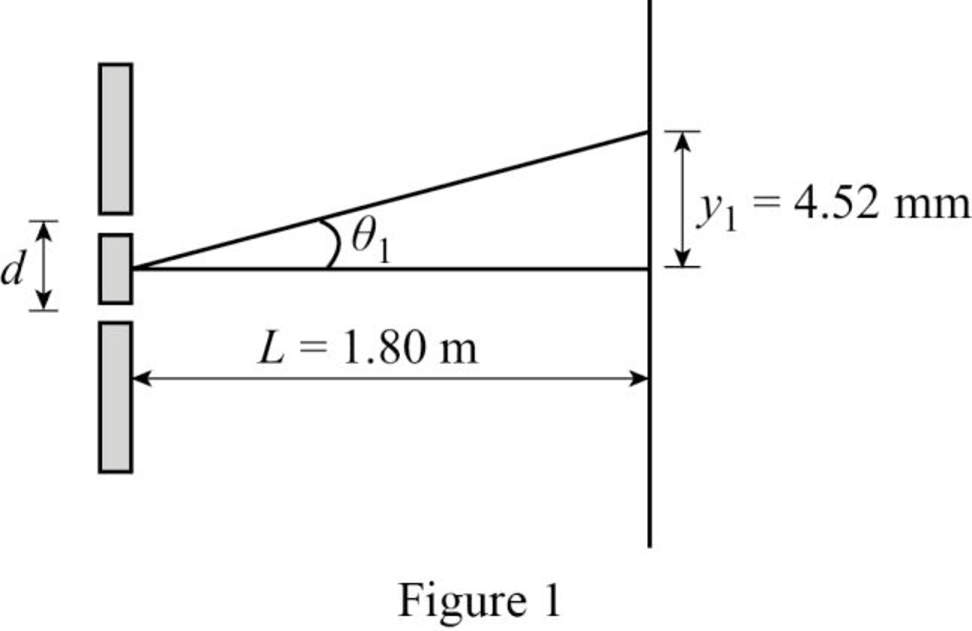
Concept explainers
(a)
The position of the
(a)
Answer to Problem 20P
The position of the
Explanation of Solution
Write the expression to find the position of the
Here,
Conclusion:
Substitute
Therefore, the position of the
(b)
The tangent of the angle the first order bright fringe makes with respect to the line extending from the point midway between the slits to the center of the central maximum.
(b)
Answer to Problem 20P
The tangent of the angle the first order bright fringe makes with respect to the line extending from the point midway between the slits to the center of the central maximum is
Explanation of Solution
The following figure gives the system description.

Write the expression for the tangent of the angle the first order bright fringe makes with respect to the line extending from the point midway between the slits to the center of the central maximum.
Conclusion:
Substitute
Therefore, the tangent of the angle the first order bright fringe makes with respect to the line extending from the point midway between the slits to the center of the central maximum is
(c)
The
(c)
Answer to Problem 20P
The wavelength of the light is
Explanation of Solution
Write the expression for wavelength of the light.
Here,
Conclusion:
Substitute
Therefore, the wavelength of the light is
(d)
The angle for the 50th-order bright fringe.
(d)
Answer to Problem 20P
The angle for the 50th-order bright fringe is
Explanation of Solution
Write the expression for angle for the 50th-order bright fringe.
Conclusion:
Substitute
Therefore, the angle for the 50th-order bright fringe is
(e)
The position of 50th-order bright fringe.
(e)
Answer to Problem 20P
The position of 50th-order bright fringe is
Explanation of Solution
Write the expression to find the position of 50th-order bright fringe
Here,
Conclusion:
Substitute
Therefore, the position of 50th-order bright fringe is
(f)
The comparison of the answers in part (a) and (e).
(f)
Answer to Problem 20P
The answers in part (a) and (e) are close but are not equal.
Explanation of Solution
The non linearity of the fringes in the screen are the reasons that the two answers are close but do not agree exactly with each other.
Therefore, the answers in part (a) and (e) are close but are not equal.
Want to see more full solutions like this?
Chapter 37 Solutions
Physics for Scientists and Engineers with Modern Physics, Technology Update
- need help part a and barrow_forwardComplete the table below for spherical mirrors indicate if it is convex or concave. Draw the ray diagrams S1 10 30 S1' -20 20 f 15 -5 Marrow_forwardA particle with a charge of − 5.20 nC is moving in a uniform magnetic field of (B→=−( 1.22 T )k^. The magnetic force on the particle is measured to be(F→=−( 3.50×10−7 N )i^+( 7.60×10−7 N )j^. Calculate the scalar product v→F→. Work the problem out symbolically first, then plug in numbers after you've simplified the symbolic expression.arrow_forward
- Need help wity equilibrium qestionarrow_forwardneed answer asap please thanks youarrow_forwardA man slides two boxes up a slope. The two boxes A and B have a mass of 75 kg and 50 kg, respectively. (a) Draw the free body diagram (FBD) of the two crates. (b) Determine the tension in the cable that the man must exert to cause imminent movement from rest of the two boxes. Static friction coefficient USA = 0.25 HSB = 0.35 Kinetic friction coefficient HkA = 0.20 HkB = 0.25 M₁ = 75 kg MB = 50 kg P 35° Figure 3 B 200arrow_forward
- A golf ball is struck with a velocity of 20 m/s at point A as shown below (Figure 4). (a) Determine the distance "d" and the time of flight from A to B; (b) Determine the magnitude and the direction of the speed at which the ball strikes the ground at B. 10° V₁ = 20m/s 35º Figure 4 d Barrow_forwardThe rectangular loop of wire shown in the figure (Figure 1) has a mass of 0.18 g per centimeter of length and is pivoted about side ab on a frictionless axis. The current in the wire is 8.5 A in the direction shown. Find the magnitude of the magnetic field parallel to the y-axis that will cause the loop to swing up until its plane makes an angle of 30.0 ∘ with the yz-plane. Find the direction of the magnetic field parallel to the y-axis that will cause the loop to swing up until its plane makes an angle of 30.0 ∘ with the yz-plane.arrow_forwardA particle with a charge of − 5.20 nC is moving in a uniform magnetic field of (B→=−( 1.22 T )k^. The magnetic force on the particle is measured to be (F→=−( 3.50×10−7 N )i^+( 7.60×10−7 N )j^. Calculate the y and z component of the velocity of the particle.arrow_forward
 University Physics Volume 3PhysicsISBN:9781938168185Author:William Moebs, Jeff SannyPublisher:OpenStax
University Physics Volume 3PhysicsISBN:9781938168185Author:William Moebs, Jeff SannyPublisher:OpenStax Glencoe Physics: Principles and Problems, Student...PhysicsISBN:9780078807213Author:Paul W. ZitzewitzPublisher:Glencoe/McGraw-Hill
Glencoe Physics: Principles and Problems, Student...PhysicsISBN:9780078807213Author:Paul W. ZitzewitzPublisher:Glencoe/McGraw-Hill Physics for Scientists and Engineers: Foundations...PhysicsISBN:9781133939146Author:Katz, Debora M.Publisher:Cengage Learning
Physics for Scientists and Engineers: Foundations...PhysicsISBN:9781133939146Author:Katz, Debora M.Publisher:Cengage Learning Principles of Physics: A Calculus-Based TextPhysicsISBN:9781133104261Author:Raymond A. Serway, John W. JewettPublisher:Cengage Learning
Principles of Physics: A Calculus-Based TextPhysicsISBN:9781133104261Author:Raymond A. Serway, John W. JewettPublisher:Cengage Learning Physics for Scientists and EngineersPhysicsISBN:9781337553278Author:Raymond A. Serway, John W. JewettPublisher:Cengage Learning
Physics for Scientists and EngineersPhysicsISBN:9781337553278Author:Raymond A. Serway, John W. JewettPublisher:Cengage Learning Physics for Scientists and Engineers with Modern ...PhysicsISBN:9781337553292Author:Raymond A. Serway, John W. JewettPublisher:Cengage Learning
Physics for Scientists and Engineers with Modern ...PhysicsISBN:9781337553292Author:Raymond A. Serway, John W. JewettPublisher:Cengage Learning





